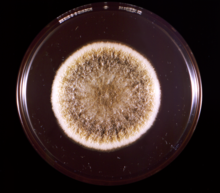
Back Aspergillus flavus Afrikaans اسبرجيلوس, فلافوس ARZ Aspergillus flavus Catalan Aspergillus flavus CEB Aspergillus flavus Czech Aspergillus flavus German Aspergillus flavus Spanish زرد افشانکچه Persian Aspergillus flavus French Aspergillus flavus Galician
| Aspergillus flavus | |
|---|---|

| |
| A conidiophore of A. flavus | |
| Scientific classification | |
| Domain: | Eukaryota |
| Kingdom: | Fungi |
| Division: | Ascomycota |
| Class: | Eurotiomycetes |
| Order: | Eurotiales |
| Family: | Aspergillaceae |
| Genus: | Aspergillus |
| Species: | A. flavus
|
| Binomial name | |
| Aspergillus flavus Link (1809)
| |

Aspergillus flavus is a saprotrophic and pathogenic[1] fungus with a cosmopolitan distribution.[2] It is best known for its colonization of cereal grains, legumes, and tree nuts. Postharvest rot typically develops during harvest, storage, and/or transit. Its specific name flavus derives from the Latin meaning yellow, a reference to the frequently observed colour of the spores. A. flavus infections can occur while hosts are still in the field (preharvest), but often show no symptoms (dormancy) until postharvest storage or transport.[3]
In addition to causing preharvest and postharvest infections, many strains produce significant quantities of toxic compounds known as mycotoxins, which, when consumed, are toxic to mammals.[3] A. flavus is also an opportunistic human and animal pathogen, causing aspergillosis in immunocompromised individuals.[4]
- ^ Masayuki Machida; Katsuyai Gomi (2010). Aspergillus: Molecular Biology and Genomics. Horizon Scientific Press. p. 157. ISBN 978-1-904455-53-0.
- ^ Ramírez-Camejo, L. A.; Zuluaga-Montero, A.; Lázaro-Escudero, M. A.; Hernández-Kendall, V. N.; Bayman, P. (2012). "Phylogeography of the cosmopolitan fungus Aspergillus flavus: Is everything everywhere?". Fungal Biology. 116 (3): 452–463. doi:10.1016/j.funbio.2012.01.006. PMID 22385627.
- ^ a b Agrios, George N. (2005). Plant Pathology: Fifth Edition. Elsevier Academic Press. p. 922. ISBN 978-0-12-044565-3.
- ^ Amaike, Saori; Nancy P. Keller (2011). "Aspergillus flavus". Annual Review of Phytopathology. 49: 107–133. doi:10.1146/annurev-phyto-072910-095221. PMID 21513456.